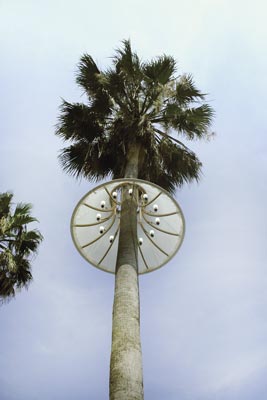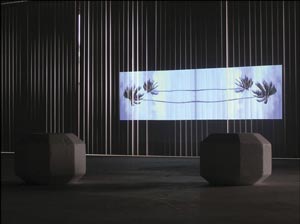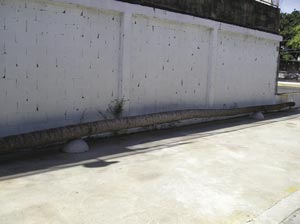Havana 1994 wasn’t perhaps the most enlightened place in the world; but it was without doubt a unique panorama to witness how a people got by despite difficulties. "I remember the nights in Havana were very dark. The seafront was very active and rafters and fishermen were seen on the horizon”, says Marxz Rosado, who captivated by the stories he had heard about the island, decided to attend a workshop at Casa de las Americas. This course, beyond helping him in his training as a creator, it would allow him to be in direct contact with Cuban reality.
The Eleventh Havana Biennial gave him the chance of meeting with the island, just at the time of his career solidification.
Marxz Rosado Ríos was formed in the Academy of Fine Arts of Puerto Rico as a sculptor, and he later made other higher studies in industrial design. This has allowed him to deploy his work in several languages and media, all with a strong presence in contemporary art practices.
His video works have been well received in international events and exhibitions, for their documentary root and for the combination of such a root with resources from the construction of the fiction audiovisual. Cruises Symphony, 2006, won an award in the arts festival Où va la Video, by the March Foundation in Padova, Italy; and The man of Islet was part of the exhibition Lesstimes than place that toured several countries in Europe and America.
In the contemporary visual landscape, where the boundaries between the art and industrial design spheres are becoming more permeable, and the aesthetic value of the objects seems to equate its use value, this artist’s latest creations are projected from the principles of design as a creative discipline. He has carried out several projects while others are still sketches and where the quality of the object is altered in order to provide new contents protected by the autonomy that makes the strictly artistic thing.
 During the Eleventh Biennial of Havana Rosado presented Diffusersfor Palms, a piece where there were palms trees with special screens typical of bedside lamps used at home to generate a warm and pleasant light. Just like his character in The Manof Islet, the artist acts as a strange doer that subverts roles and appearances, doesn’t make hierarchical spaces, dissects and rearticulate referents in the name of a change. He thus generates sense dynamics from the ludic base, from a liberating doing where imagination has no brakes.
During the Eleventh Biennial of Havana Rosado presented Diffusersfor Palms, a piece where there were palms trees with special screens typical of bedside lamps used at home to generate a warm and pleasant light. Just like his character in The Manof Islet, the artist acts as a strange doer that subverts roles and appearances, doesn’t make hierarchical spaces, dissects and rearticulate referents in the name of a change. He thus generates sense dynamics from the ludic base, from a liberating doing where imagination has no brakes.
The binary character nature-technology is present in his work, but not with an outdated romanticism having in the idyllic natural an ideal and hypocrite end, but from the position that leads to rethink a sustainable technologicalfuture. Then the ideal place to locate his pieces is the public space. There is where confrontation is exercised, where the subject immersed in everyday life makes a brief halt at those huge palm trees, decorated as dressing table lamps; and that's where he lives, just imagine, surrealand possible landscape.
Do you usually work on elements of domestic origin, resizing them to other areas?
I have several pieces where I turn to the domestic universe. These spaces are constant inspiration to me, for in them you spend most of your time. Generally people modify sites of creation, working sites, to make them similar to their homes, often by the inclusion of some element that hosts the sense of "home". In this piece I proposed for the Biennial I wanted to appropriate a referent very defined to that world, and reuse it adding another connotation.
I liketo usethe palmasresistance element. This plantis presentin different geographical areas. Hurricanesin the Caribbeangoandcannot devastate them. The windturns them around, they staggerbut being so flexiblethey do not breakand manage tostand.I’m interested in this adaptabilityand malleabilitythey have,and it is onthis qualitythatI workto generatethe most diversesenses.
Describethe assembly process...
Strenuous...though there were only twodayssetting up and two daysin the studiomakingthe screens. Butindeedthe designfor assemblyissimple.I wanted to bringsomething that waseasyfor transportationand location and thatall depends onmyinvestmentand myown energy.
The principle of the work is simple, its implementationand itsparts, but certainly there is a charmthat transcendsthe image. It can be adecorative element, but it's somethingthat aestheticallysends us back toan experience.It is well connected tothe idea thatart isexperience, beauty experienceand good life experience.
Unlike creative trendsthat bet for critics, called "hard-line" or a positionofdefined"policy", this projectissomething lighterandethereal;is a piece foraesthetic enjoyment, butit makes you thinkfromhis poetry.Inthe act of"moving" elementsfrom some contexts to other ones, making that something totally alientospacereach there,residesthe somewhatmysticaldimensionof art.
At night the"lamps" are transformed, andthe landscape becomesamazing. Imagine therehad been morepalm trees; one afterthe other, the impactwould be amazing...
In your opinion... whatrole doesdesign(often associated with the culturalproductsmarket) plays in the designofcontemporary art practices?
The connectionis given, in my opinion, bythinking artistic proposals from design operating strategies. This has been responsible for developing new ways of life: the technological contexts of human resources culture, the structuring of natural and artificial means, are some scenarios where we deal with design. The art reflects and discourses on the changes taking place at sociopolitical, anthropological and aesthetic level. Internet is largely responsible for the changes in both platforms, and the aesthetics of the digital decoding. This practice is seen in a detour to the object area and shows an integration artistic strategy for both sectors. It is also perceived in the principles of sustainable design, energy performance, environmental justice and policies on recycling, reuse, salvage and re-contextualization of resources, space and energy.
Butwe don’t see just a technological link of design and art; there is also a level of communication, intellectual property, industrial and handicraft production as well as in terms of life cycles in which we appreciate this codes change. Art, when attached to the object and the objectivity of visual communication, uses design at its most basic character.
 From whatperiod design is linked to your artistic work?
From whatperiod design is linked to your artistic work?
I decided to studydesign in my senior year of college, when I was training myself as a sculptor. That was in 1995. And I finally made this project in Milan (1997). It was an important period of great decisions in regard to sustainable design and globalization. For me it is an instrumental discipline, a way to view, analyze and program the built world, and the one I know we will build. In 1998 I did an exhibition titled The last rain in which I used projectable practices of design to make art.
Tell us about yourforay into video, and how you conceive the video-creation on regard to other media, and languages?
I started withReflected sceneries. It was a two chapters’ video-installation, a still shot of a landscape of palm trees with the horizon of the sea in the background, and another shot of a palm tree and its reflection which seemed a mythological creature flying with sky background. These images were projected onto vertical blinds covering a glass window to the outside, and a fan from a corner moving the curtains and creating a winding wave and allowing a slightly hinting light seen. It was a reflection on the media in the construction of the landscape and the individual. In my last two videos I work superimposing everyday life real stories with planned stories or actions on the real plot. I like to call them "fiction documentary", and I'm interested in the narrative structure that can be achieved.
How do you thinkyour work is inserted into the thematic and discursive patterns proposed by this edition of the Havana Biennial?
I presentedthree proposals for the Biennial, ranging from a stronger line of discourse, till this one, where apparently aesthetics is a priority. It's actually a project I've been working in since 2007, a landscape of palm trees. As a designer and artist, I was interested in reversing the order of the elements that distinguish the own space towards the public. I then use household items to put them in urban space. I mean, I bring the house to the city.
Andthis was the first point of communication of my work with the Biennial budgets. Social imaginary thingsarebasically strengthened in a space like the house: this is a part of the interior of our life that, in a sense, is transferred to the public arena.
Butnot only that, the work itself is a lamp inserted into a palm tree. It is a symbol of strength, power of the idea, the enduring, as a light longer. These are the principles that caught my attention and that I wanted to express with this proposal.
 After almost twenty years without visiting Havana, how you perceive it now? Tell us more about your first visit. What impression did you get from the cultural scene then?
After almost twenty years without visiting Havana, how you perceive it now? Tell us more about your first visit. What impression did you get from the cultural scene then?
At that timeI was a still student. I came here to make a feather art course at Casa de las Americas. I did it more out of curiosity, I wanted to know what it was Cuba and what happened with it, and that's what impelled me to do it. I already had interests in design, but I worked more with sculptural assemblages of recycled artifacts, light, liquid detergents and organic elements such as plants, water, fire, dry ice, etc. Icreated characters, machines and built fanciful cities.
Back then there were so many blackouts, shortages. I did not have much contact with the art scene of the time. I remember talking briefly with filmmaker Enrique Pineda and the artist Ernesto Pujols. Apparently people were quiet, I talked the island time, resting from the heat and commenting the every day. It was already possible to see a growth in the tourism industry of the capital. But twenty years ago was more accessible in economic terms, now is a bit more expensive.
Obviously Havana has grown a lot since then. I believe that despite all it is very hospitable. From all the things I've always been told, it is most certain the need to be fit, and I feel that`s great, it is a teaching that must be taught to everyone. And you have to do it with what's there, and do it the best possible.
Related Publications

How Harumi Yamaguchi invented the modern woman in Japan
March 16, 2022












